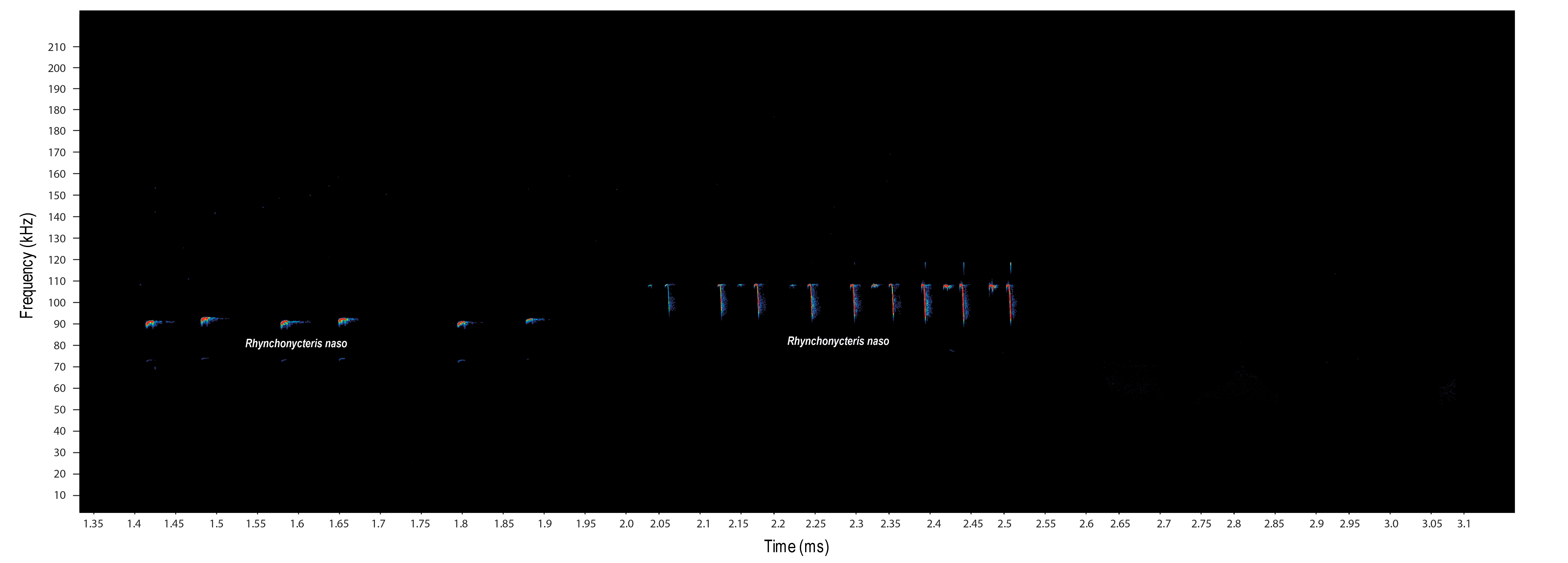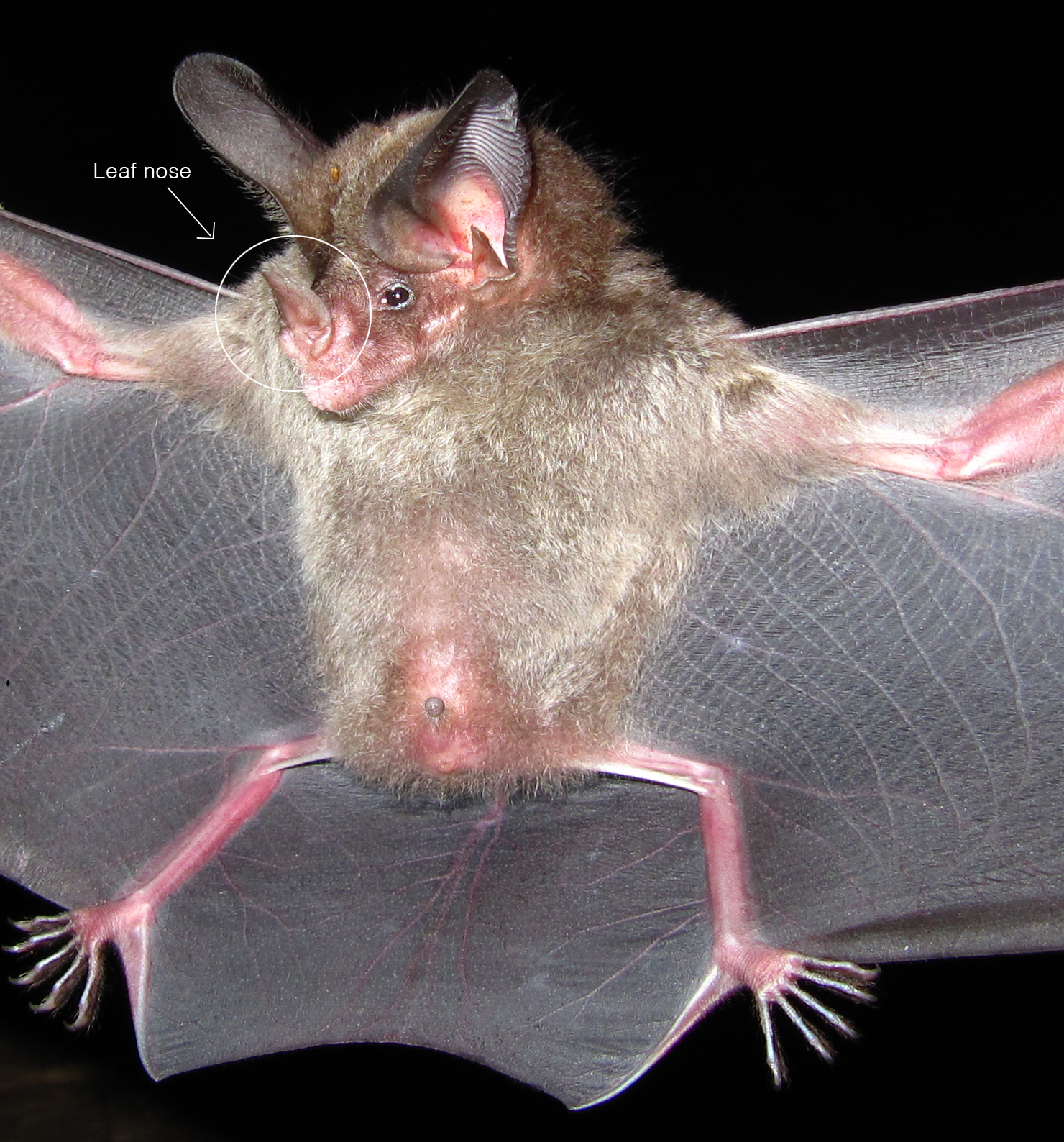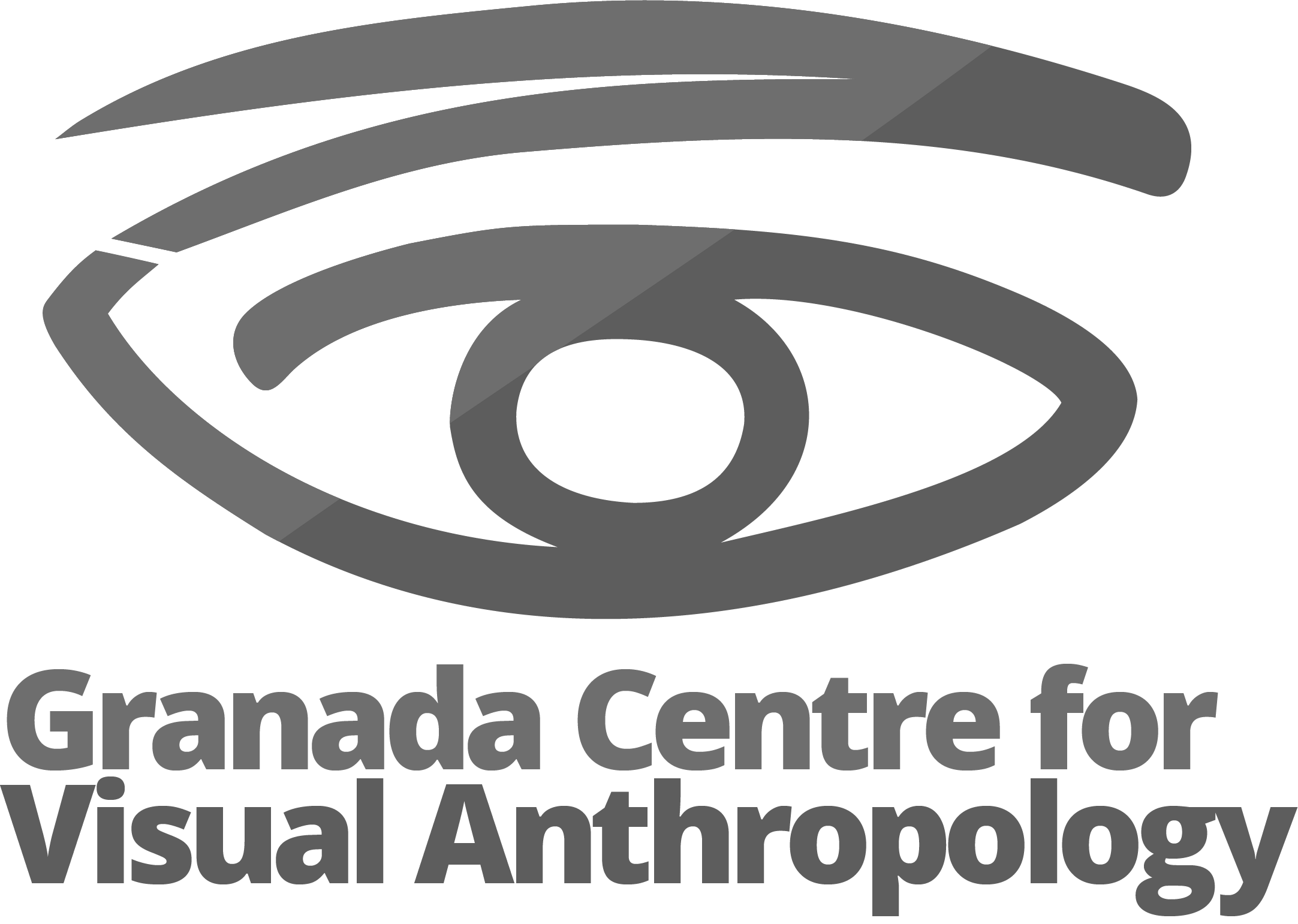Rhynchonycteris naso in three phases
Ultrasound / human hearing range
(by Danny Zurc & Alejandro Valencia-Tobon)
Bat sound signals appear to be divided into three phases: search, approach and terminal phase (this latter one also called ‘feeding buzz’).
These phases are indications of the bat’s activity: in the search phase, bats seek food and, while doing this, each individual is analysing what is happening in its habitat.
Encountering possible prey, bats go towards it, emitting pulses at shorter time intervals (approach phase).
Finally, during the feeding buzz, bats are so close to their possible prey that pulses are emitted at incredibly short time intervals in order to rapidly obtain information about what is happening and thus have a successful hunt. This process is repeated over and over again.
These ultrasonic vocalisation records can also be used for biological identification because bats’ ultrasound signals are unique to each species. Here we have Rhynchonycteris naso, which is an interesting animal from South and Central America.
Individuals of this species emit ultrasound from 95.0 to 103.5 kHz, which means that they produce high intensity sounds. With this information we are able to study how bats navigate and use echolocation.
We then convert the recordings to the human hearing range to allow people to audibly appreciate the sounds.

Returning echoes
(by Danny Zurc & Alejandro Valencia-Tobon)
Most bats emit and detect ultrasound signals while flying, in a process known as ‘echolocation’ (they have an active sonar system). The principle behind echolocation is to emit high-frequency signals (in bats, mainly ultrasonic signals above 20 kHz) and then analyse those returning echoes. By detecting such returning echoes, bats can recognise, classify and localise those objects that reflected back sound signals.
The problem is that bats confront multitude of issues and masking effects while flying; for example: dealing with external noise, clutter echoes, sound signals emitted by other bats, and the physical effects (temperature, humidity and distance) that generate an atmospheric attenuation of sound. Such ecological constraints have meant a selection pressure which seem to have led to an adaptation process in which ultrasound signals appear to be unique to each species. Biologists came to this conclusion by comparing narrowband and broadband components of echolocation signals.
Note: similar echolocation principle is used by humans. For example, blind people can make mouth click sounds and use the returning echoes to locate possible obstacles. Other applications include submarine sonar systems and the detection of underwater mining, and the ultrasound scan that physicians use to obtained medical images of different organs.


Leaf-nosed bats
(by Danny Zurc)
Bats species have different nose forms. Studies have suggested that this complex organ is a highly functional structure.
For example, some echolocation calls are emitted by bats from nasal passages, in a process known as ‘nasal emission’. Those nasal-emitting bats have ‘noseleaves’, a structure that might serve acoustic functions. One hypothesis is that the bats moves the nose-leaf during echolocation, probably to control the vertical distribution of orientation sounds.
Micronycteris microtis is good example of such specialised-facial-morphology bats. This member of the Phyllostominae sub-family can be found in South and Central America. This species uses its nose when producing echolocation calls to better localize and target objects.
Such calls have broadband pulses containing several harmonics between 50 and 160 kHz. In this recording, made in the Caribbean region of Colombia, Micronycteris microtis was registered with a peak frequency of 80 kHz (fig. 2). This species also has large ears (18-22 mm), which is a useful morphological characteristic by which to recognise it.
In Colombia it inhabits Andina and Caribbean regions from 0 at 310 masl. (Photo by Andrea Bustca).


Leaf-nosed bats
(by Danny Zurc)
Rhynchonycteris naso is an interesting animal from South and Central America. It is an insectivorous species that you can find resting under houses roofs (wood roofs) or wooden logs. Individuals of this species emit ultrasound from 95.0 to 103.5 kHz, which means that they produce high intensity sounds. It is also interesting to see that family members are very ‘organised’: while resting they form a line, one next to the other, as seen in the picture.
Although Rhynchonycteris naso is the scientific name, this animal is also known as ‘proboscis bat’ or ‘long-nosed bat’. Because of this, native people from the Caribbean region in Colombia usually make fun of this species, saying that it looks like a ‘mini-pinocchio’.
Smilisca phaeota
(by Camilo Arredondo)
The New Granada cross-banded tree frog (also known as ‘rana bueyera’ in Colombia) is a common medium-size species (40–70 mm) with large limbs and round head and is found from Honduras to Colombia and Ecuador. In Colombia, this species typically inhabits lowlands in the northern Caribbean plains, the Pacific coast, the inter-Andean valleys and the foothills of all three Cordilleras.
This tree frog can be found both in well-conserved forest as well as in open areas modified by human activities. The body coloration of this species varies; however, it can be easily recognized by a dark green line covering the sides of the head through the eyes and extending past the tympanum.
As with most frogs and toads, Smilisca phaeota males are responsible for singing, both in reproductive and defensive situations. Males usually sing while on the surface of small and shallow ponds or near to low-flow streams. This species exhibits great variety in the composition and structure of its call, from differences in the number of notes, duration and pitch of the sound. These call variations are most evident between Central and South America populations. Furthermore, the advertisement call of Colombian populations is characterised by a single note (sporadically two), where the sound produced is like a short call from a calf.







